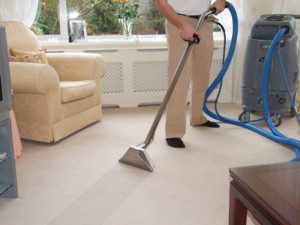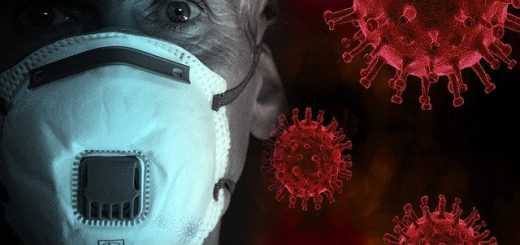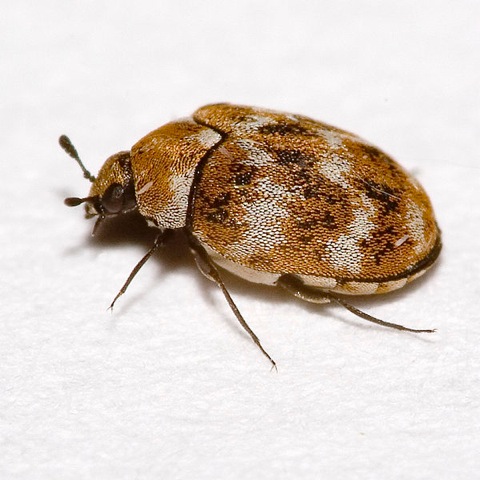The Top 5 Dangers to Carpet and How to Avoid Them
One of the most popular ways to add texture, warmth, depth, and a flash of your own personality to your home is by having carpet installed in your living spaces.
 Carpeting lasts between 10 and 15 years on average, but if you don’t care for it properly, you may end up needing to replace it sooner than you expected. The average cost to replace carpet is between $7.11 and $12.22 per square foot, and it usually requires professional help. Because it’s more delicate than other materials, like hardwood, a simple stain or unchecked damage can have devastating effects. To keep your carpet in tip-top shape, there are some hidden dangers that you should be aware of and know how to prevent.
Carpeting lasts between 10 and 15 years on average, but if you don’t care for it properly, you may end up needing to replace it sooner than you expected. The average cost to replace carpet is between $7.11 and $12.22 per square foot, and it usually requires professional help. Because it’s more delicate than other materials, like hardwood, a simple stain or unchecked damage can have devastating effects. To keep your carpet in tip-top shape, there are some hidden dangers that you should be aware of and know how to prevent.
We are here to help ensure your carpeting gets the long-lasting life it deserves by providing the top five dangers and the best ways to mitigateTo mitigate is to reduce or limit the severity of damage, ri... More and prevent them.
Water and Moisture
Water and moisture come in at the top of list due to the considerable amount of damage they can do in such a short time span. When water is left on a carpet, the moisture flows down into and through the carpet pile and onto the underpadding. This makes it nearly impossible to thoroughly dry the installed carpet. The underpadding, which experiences really limited airflow, becomes damp and this can quickly leadLead is a heavy metal that can be toxic to humans, especiall... More to mold, mildewMildew is a type of fungus that grows on damp surfaces, typi... More, and musty smells.
Accidental spills aren’t the only way that water and moisture can affect your carpets and rugs though! You need to consider the moisture and humidityHumidity is the amount of moisture or water vapor present in... More levels where the carpets and rugs are placed. Even without direct contact of water, there are many cases of dry rot occurring from long-term moisture weakening the carpet itself.
Mitigation
Small spills can be cleaned by blotting the area with a clean paper towel to remove as much moisture as possible and then using fans to finish the dryingDrying is the process of removing moisture from materials, s... More. Of course, if the water damage is too severe, you’ll want to consider replacing your carpet to avoid bacteria and moldMold is a type of fungus that grows in damp or humid conditi... More growth.
Prevention tips
Check the areas where you plan to install carpeting. By their very nature, basements are often damp, and kitchens and bathrooms come with high spill risks (as well as humidityHumidity is the amount of moisture or water vapor present in... More if not ventilated properly). For these rooms, if you’re sure you want carpet, you should consider running a dehumidifierA dehumidifier is a device that removes excess moisture from... More or finding other ways to ensure ventilationVentilation is the process of exchanging or circulating air ... More and dryer air.
Mold Spores
Mold spores are constantly afloat in the air around us and for the most part cause no harm. But given the right conditions, they can quickly wreak havoc on your carpet and your health. As mentioned above, carpeting is susceptible to moisture because it can be difficult to dry. As moldMold is a type of fungus that grows in damp or humid conditi... More sporesSpores are microscopic reproductive units of fungi or mold t... More make gentle landings onto moist carpets or rugs, they quickly take hold. Feeding on the dust and thriving in the moisture, a moldy condition will soon get ugly.
MoldMold is a type of fungus that grows in damp or humid conditi... More issues can range from mild cases consisting of musty smells with no visible damage to visible splotches of moldMold is a type of fungus that grows in damp or humid conditi... More growth covering pieces of the carpet or rug. Not only can it damage the carpet, but your health may be affected as well. Inhaling or touching moldMold is a type of fungus that grows in damp or humid conditi... More may cause allergic reactions too, which is why mitigation and preventionPrevention refers to actions taken to reduce the likelihood ... More are ultra-important.
Mitigation
 For visible moldMold is a type of fungus that grows in damp or humid conditi... More growth, it’s best to remove and replace the carpet entirely. Unless it’s limited to a very small area and a patch can be applied, the safest bet is to start from scratch. For suspected but still invisible growth, professional steam cleaning applications with detergents may be enough to fully remove the moldMold is a type of fungus that grows in damp or humid conditi... More and moldMold is a type of fungus that grows in damp or humid conditi... More sporesSpores are microscopic reproductive units of fungi or mold t... More. Most importantly, after the steam cleaning is complete, the carpet or rug must be dried all the way through in order to prevent the same issue from happening again.
For visible moldMold is a type of fungus that grows in damp or humid conditi... More growth, it’s best to remove and replace the carpet entirely. Unless it’s limited to a very small area and a patch can be applied, the safest bet is to start from scratch. For suspected but still invisible growth, professional steam cleaning applications with detergents may be enough to fully remove the moldMold is a type of fungus that grows in damp or humid conditi... More and moldMold is a type of fungus that grows in damp or humid conditi... More sporesSpores are microscopic reproductive units of fungi or mold t... More. Most importantly, after the steam cleaning is complete, the carpet or rug must be dried all the way through in order to prevent the same issue from happening again.
Prevention tips
Reducing the moisture your carpets are exposed to is an excellent way to prevent moldMold is a type of fungus that grows in damp or humid conditi... More from growing. Carefully selecting carpet locations along with reducing indoor humidityHumidity is the amount of moisture or water vapor present in... More can help too. Ideal indoor humidity levels are between 30% and 50%. If you live in an area plagued by constant high humidityHumidity is the amount of moisture or water vapor present in... More, consider using solid, rubber-slab carpet padding with antimicrobial properties. Although it’s slightly more expensive upfront, it can save you a lot of time and money down the line.
Pests
Pests come in all shapes and sizes, from the squeaky field mouse all the way down to the tiny carpet beetle which measures less than half an inch in length. These pests get into our homes and search for food and shelter, especially in our woolen clothes, rugs, and carpets. The damage done by hungry carpet beetle larvae, for instance, can range from small lines of missing or shortened carpet pile all the way to large patches eaten clean down to the backing.
Mitigation
Carpet beetles do leave some tell-tale signs that they’re hatching in your home and will soon be (or already are!) feeding on your carpet. Signs like holes, fecal pellets, and larvae mean it’s time to act as the beetles have already made your home their own! Vacuuming all affected areas and introducing heat (a hair dryer will do the trick!) will clean up and kill larvae. Just be sure to take care of all areas of infestation. If the problem is a bit more widespread, introducing sticky or pheromone traps is a safe and effective solutionA solution is a homogeneous mixture of two or more substance... More to capture adult beetles who may be looking for a place to lay their eggs.
Prevention tips
Keeping adult carpet beetles outside of the house is your best line of defense. Check your window screens and doors for holes and gaps and fix or patch them if any exist. If you’re keen to bring fresh cut flowers into your home, be sure to check for any hitchhikers as this is one of the most common ways the pests get inside. The sticky or pheromone traps can also be kept in place as a preventative measure to trap any adult beetles that may have made it in even with your best preventionPrevention refers to actions taken to reduce the likelihood ... More efforts.
Pets
 With over 63 million households in the United States owning at least one dog and nearly 43 million with at least one cat, it was imperative that we consider pets (or family members as some of us are apt to call them!) as one of the top five dangers to your carpeting and rugs.
With over 63 million households in the United States owning at least one dog and nearly 43 million with at least one cat, it was imperative that we consider pets (or family members as some of us are apt to call them!) as one of the top five dangers to your carpeting and rugs.
Pets are our lovable furry friends, but they can do quite a bit of damage to our carpeting. They track in dirt with their muddy paws, dig or scratch, and have the occasional accident, hairball, or vomiting incidentAn incident is an event or occurrence that causes damage, di... More.
Quick action when these issues arise can help to limit damage, but if too much time (or too much digging) goes by, we are often left with stained, smelly, or ripped carpeting and rugs.
Mitigation
Act quickly, before a mess soaks to the under padThe pad is the cushion or underlayment beneath carpet that p... More. Blot up the excess liquid and rinse with water. Be careful not to use too much water and to dry completely so the risk of moldMold is a type of fungus that grows in damp or humid conditi... More and dry rot is reduced. The Humane Society warns against using steam cleaners or strong smelling chemicals like ammonia or vinegar for pet messes as these can actually set the smell in your carpet or encourage pets to use the area again.
Prevention tips
Provide your pets with proper scratching pads, toys, and attention to reduce or eliminate digging and scratching. Ensure that litter boxes are kept clean so your cat isn’t tempted to go elsewhere and that your dog has enough outdoor time in the yard or on a walk so accidents are reduced. Of course, positive reinforcement is a great approach to preventing accidents too!
Chemical Treatments
Chemical treatments, also known as “washes”, pose a hidden threat to carpets. Most are given a chemical wash before they even make it to the store. These washes are usually harmless as their purpose is only to wash away impurities and rinse off any excess dye. However, there are three types of washes which can begin to damage your carpet before you even lay it down – luster, antique, and tea wash. The side effects that these washes have are color fading, pile distortion and fiber breaking, stain susceptibility, and odors.
Mitigation
Unfortunately, if you have a chemically treated carpet in your home, there is not much more you can do. Keep the carpet dry, clean, and free of pests. If you do need to clean it, take care to research the type of wash you have and ensure you’re using the proper cleaning materials.
Prevention tips
Inspect all carpet before purchasing. Here are some tips to identify washes while you’re shopping: Luster washes make wool appear as silk and the fiber bases will be darker than the tips. Antique washes have a strong color change from the front to the back of the carpet. Tea washes have an overall gold or brown tone, and the white fringes are beige. The fiber tips are darker than the bases. Spotting these signs can let you know what you’re in for if you choose to install this carpet and can prevent further damage down the line.
Summary
Carpeting isn’t going anywhere and will continue to bring a sense of style and comfort to our living spaces. Being informed about the dangers that can affect carpeting and rugs as well as how to avoid them is our best line of defense to keep them looking good and lasting long. Some damages are unavoidable though, and it may be necessary to contact a professional. The quicker you take care of any damage, the less risk you have of long-term side effects.












